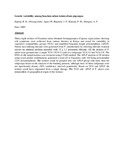| dc.contributor.author | Kiprop, E. K. | |
| dc.contributor.author | Mwang'ombe, AW | |
| dc.contributor.author | Baudoin, J. P. | |
| dc.contributor.author | Kimani, P. M. | |
| dc.contributor.author | Mergeai, A. F. | |
| dc.date.accessioned | 2013-02-13T14:36:44Z | |
| dc.date.available | 2013-02-13T14:36:44Z | |
| dc.date.issued | 2005 | |
| dc.identifier.citation | African Crop Science Journal, Vol.3. No.3, pp. 163-172,2005 | en |
| dc.identifier.uri | http://erepository.uonbi.ac.ke:8080/xmlui/handle/123456789/9808 | |
| dc.description.abstract | Thirty-eight isolates of Fusarium udum obtained frornpigeonpea (Cajanus cajan) plants showing wilt symptoms were collected from various districts in Kenya and tested for variability in vegetative compatibility groups (YCG) and amplified fragment length polymorphism (AFLP). Nitrate non-utilising mutants were generated from F. udumisolates by selecting chlorate-resistant sectors on minimal medium amended with 15 g 1.1 potassium chlorate. All the isolates of F. udum were grouped into a single YCG (YCG I) with two subgroups YCG I I and YCG.I Il. The DNA of-the fungal isolates was extracted using CTAB method. The AFLP analysis of 38 isolates using seven primer combinations generated a total of3 is fragments with 102 being polymorphic (32% polymorphism). The isolates could be grouped into one AFLP group with more than ten subgroups based on the analysis of the banding patterns, although most of these subgroups were not significantly distant «50% confidence. interval) genetically. Based on YCG and AFLP, the isolates could have originated from a single lineage. The YCG and. AFLP of F. udurn were independent of geographical origin of the isolates. | en |
| dc.language.iso | en | en |
| dc.subject | AMPLIFIED FRAGMENT LENGTH POLYMORPHISM | en |
| dc.subject | CAJANUS CAJAN | en |
| dc.subject | FUSARIUM UDUM | en |
| dc.title | Genetic variability among fusarium udum isolates.from pigeonpea | en |
| dc.type | Article | en |
| local.publisher | Department of Plant Science and Crop Protection | en |


